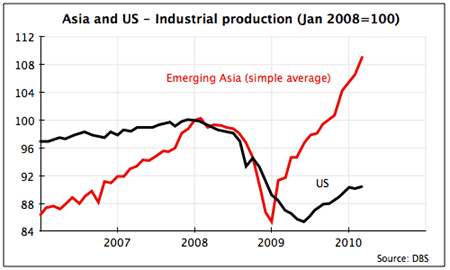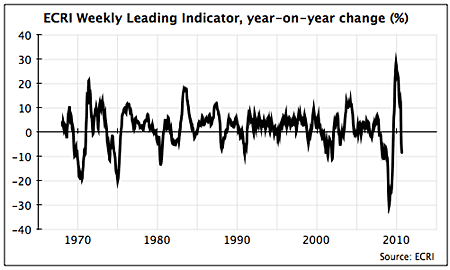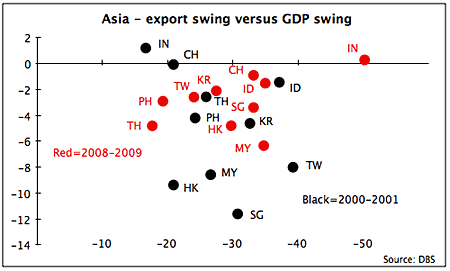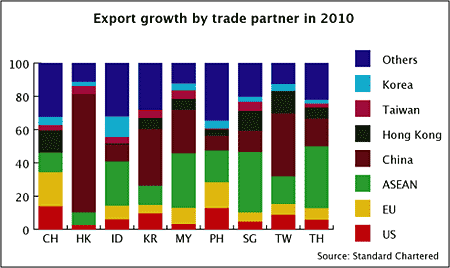Which Asian countries can survive a US downturn?
Asia's economic recovery has beaten all previous records. But the continent is not isolated from the rest of the world. And now fears of a double-dip recession in the West are growing as key economic indicators turn down. Here, Cris Sholto Heaton looks at how a slump in the US would hit Asia, and which countries are likely to fare the best.

Asia central banks are rapidly moving ahead of their global peers. In the last couple of weeks, Korea, Taiwan, Malaysia and India have all raised interest rates. Thailand and the Philippines could follow as soon this week. Meanwhile, the Fed, the Bank of England and the European Central Bank remain firmly fixed on their emergency ultra-low rates.
In some countries notably India this is an attempt to deal with inflation problems that could get out of hand. But generally, inflation is not yet an issue in most of Asia's economies. Instead, higher rates reflect growing confidence in a recovery that has beaten all previous records.
But is the outlook as strong as this suggests? Let's take a look at what the next few months might hold and what it could mean for Asia
MoneyWeek
Subscribe to MoneyWeek today and get your first six magazine issues absolutely FREE

Sign up to Money Morning
Don't miss the latest investment and personal finances news, market analysis, plus money-saving tips with our free twice-daily newsletter
Don't miss the latest investment and personal finances news, market analysis, plus money-saving tips with our free twice-daily newsletter
Asia has seen a spectacular rebound
Based on what's happened so far, emerging Asia has good reason to feel confident. The region has recovered far more strongly than the West, as the chart below shows.

Smaller economies are still seeing GDP grow at double-digit rates. And if you take quarterly data and annualise them, larger economies such as China, Korea, India and Indonesia are growing at roughly 6-10% a year. (Most emerging economies only report GDP growth in year-on-year terms, which gives a misleadingly high impression of the actual pace for China. Estimates of the actual quarter-on-quarter pace are lower but still impressive.)
But will the second half look as good? Probably not. In some cases, the rate is simply unsustainable. Singapore has grown at an annualised quarter-on-quarter pace of more than 35% in the first quarter, and probably at a similar rate in April-June as well. This is thanks in part to exceptionally high production in its volatile pharmaceuticals sector. A pace like that can't be maintained for long.
A US slowdown could hit Asia's recovery
And conditions in many parts of the world are becoming less favourable. Meanwhile, Asian economies are not isolated from what happens in the West. Fears over a double-dip recession in the US are growing on theback of the turndown in some indicators. These include the ECRI Weekly Leading Indicator, as the chart below shows.

A double-dip is possible, but the risks may be overstated. The latest plunge in the ECRI follows a rise earlier in the year that on past trends would have pointed to an 8% GDP gain in the first quarter. This has not been a typical recession, so it's quite possible that any predictive value the ECRI WLI has may be lower than usual.
More generally, true double-dip recessions are rare. There was one in 1981, when Paul Volcker aggressively raised rates to squash inflation. And there was arguably one in 1937 (depending on how soon you think a recession needs to come to qualify as a double-dip). That took place at a time when both fiscal policy and monetary policy were being tightened strongly.
Higher interest rates are extremely unlikely now or for the next year or so. So history suggests that a double-dip is unlikely. But a noticeable slowdown seems quite probable.
China is applying the brakes
Then there's China. Earlier in the year, when many pundits were worrying about China overheating, I mentioned that there were tentative signs that the economy was actually starting to slow in many areas. That trend is becoming more noticeable.
In particular, the government has clamped down hard on real estate to stop the property market in major cities from overheating further. Sales are down sharply, prices are starting to roll over, and construction activity is starting to drop. Local government building projects have also come under scrutiny amid fears of poor quality projects leading to rising bad debts.
Expert tips & advice for investing in Asia! Claim your FREE guides from MoneyWeek that include:
- How to go about investing to Asia
- Which brokers to use to buy foreign shares
Construction is a major part of the Chinese economy, as tends to be the case in any fast-developing economy. So a slowdown here will have a major effect. GDP is likely to fall towards the 8-10% region which is probably China's sustainable rate over the next few years. But a bigger drop is possible.
And don't forget the problems in the eurozone. Concerns over the solvency of European banks are very real. We're not back where we were two years ago when the fears were over the whole global financial system. But they are an added worry for markets and help ensure that eurozone economies will remain stagnant.
Smaller economies could be hit
So what will the impact be across Asia? The outcome is likely to vary. The chart below is slightly complicated to read, but bear with it. It shows the swings in export growth and GDP growth for Asian economies in the last two global recessions. (Red = 2008-2009 and black = 2000-2001.)

You can see that Hong Kong and Singapore, as major trade hubs, are always hard hit by a downturn. Malaysia is also very vulnerable. Being a tech centre and exporter, Taiwan is very geared to the global technology and business investment cycle, so felt the effects of the dotcom bust especially strongly.
Large economies such as China, India and Indonesia were relatively immune. Domestic consumption and investment are more important than exports, even if the export swings are relatively large. That means that resilient consumption or government stimulus programmes can have a much bigger impact in these economies.
Also, if China is going to slow down sharply this time, we need to think about the effect that Chinese growth has had on its neighbours during the recovery. So the chart below breaks down the export recovery for each country by its trade partners. (India isn't included here, but as the earlier chart suggests, exports demand is relatively unimportant for the Indian economy.)

This suggests that the US is only a significant contributor for a few economies. And Europe is only really relevant to China and the Philippines. Regional trade looks far more important.
The snag is that a lot of regional Asian trade is intermediate exports ultimately destined for the West. For example, electronic components from Malaysia assembled in China for export to America. It's hard to be sure how big a contribution this is, but it is meaningful.
In any case, if we're expecting a slowdown in China, renewed weakness in America and a sluggish eurozone at the same time, we can assume that the likes of Hong Kong and Taiwan will feel the effects based on their combined exposure. Indeed, Taiwan's decision to raise rates was rather surprising given that inflation is not a problem, and while growth has been strong, the outlook is not that solid.
That said, what is quite striking on the chart is the importance of trade within ASEAN to the ASEAN members. (ASEAN the Association of Southeast Asian Nations includes Indonesia, Malaysia, the Philippines, Singapore and Thailand, as well as Vietnam and some smaller local economies not featured here.) Again, it's difficult to know how much of this is domestically driven and how much is linked to eventual exports in some way. But on face value, it suggests that regional trade is becoming more significant.
It's easy to dismiss ASEAN, both as a trade block and as an investment compared to the hot stories of China and India. Certainly, progress on creating a meaningful freer-trade zone has been slower than it should have been. Most of the economies within it have problems that need to be dealt with.
Still, there is more going on in terms of regional integration and development than many outsiders assume. The ASEAN story shouldn't be overlooked. I'll come back to this in a future issue of MoneyWeek Asia.
A slowdown shouldn't spark another sell-off
For now, we need to be ready for less bullish news in Asia over the new few months. The region won't necessarily go into recession again. The odds are that it won't. But it won't be full steam ahead in the smaller economies.
On the other hand, some countries should be relatively resilient notably India and Indonesia. Indeed, with India's inflation stubbornly high, the concern there will be to prevent overheating. India can probably grow at 7-8%, while Indonesia could manage around 6%, despite some exposure to China through commodity exports. Only a much more serious slump especially a freezing of financial markets again would be likely to have a serious impact on them.
And all of this should be reasonably apparent to markets. It's not the most favourable situation for further gains, but if a second half slowdown sparks another sell-off, markets will have done a very poor job of pricing in the obvious. And if we do have a slowdown, what would be encouraging would be any sign that investors are starting to be a bit more discriminating in the way they look at Asia.
As we know, Asian markets were hit much harder than developed ones during the panic in 2008. They then recovered more rapidly. When the rally ran out of steam and turned down at the end of the year, Asia was again hit slightly harder, although not on a par with the previous time.
But in the last few months, things have been different. The MSCI Asia ex-Japan is down around 6% over six months, while the S&P500 is down more, at around 7%. The Jakarta Composite is up 11%, while the Hang Seng China Enterprises has fallen slightly more than the S&P.
We shouldn't read too much into this yet. I see a lot of comment these days to the effect that emerging markets are safer and more reliable bets than the developed world. And there's no doubt that the best emerging markets are in some ways in a better position than those in the West. At the same time, the idea that EMs are ready to be seen as a safer bet is wrong. When investors panic, they will still flee back to the dollar.
But over time, that should change. With globalised markets, complete decoupling is never going to happen. However, Asia should gradually become more independent of Wall Street. And any evidence that this is happening and that investors are distinguishing between Asian markets during the next slowdown will be very welcome.
This article is from MoneyWeek Asia, a FREE weekly email of investment ideas and news every Monday from MoneyWeek magazine, covering the world's fastest-developing and most exciting region. Sign up to MoneyWeek Asia here
Get the latest financial news, insights and expert analysis from our award-winning MoneyWeek team, to help you understand what really matters when it comes to your finances.
Cris Sholto Heaton is an investment analyst and writer who has been contributing to MoneyWeek since 2006 and was managing editor of the magazine between 2016 and 2018. He is especially interested in international investing, believing many investors still focus too much on their home markets and that it pays to take advantage of all the opportunities the world offers. He often writes about Asian equities, international income and global asset allocation.
Cris began his career in financial services consultancy at PwC and Lane Clark & Peacock, before an abrupt change of direction into oil, gas and energy at Petroleum Economist and Platts and subsequently into investment research and writing. In addition to his articles for MoneyWeek, he also works with a number of asset managers, consultancies and financial information providers.
He holds the Chartered Financial Analyst designation and the Investment Management Certificate, as well as degrees in finance and mathematics. He has also studied acting, film-making and photography, and strongly suspects that an awareness of what makes a compelling story is just as important for understanding markets as any amount of qualifications.
-
 Asia's new tiger economy: MoneyWeek Talks
Asia's new tiger economy: MoneyWeek TalksPodcast MoneyWeek's editor, Andrew van Sickle, speaks to Dragon Capital's Thuy-Anh Nguyen about Vietnam's remarkable rise
-
 How much do you need to earn to afford the average rent?
How much do you need to earn to afford the average rent?Rental growth is slowing and making rents more affordable for tenants, but what hwo much do you need to earn to afford the average UK rent?
